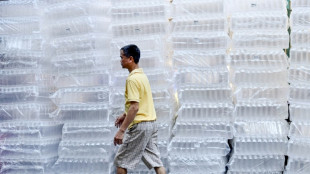
-
 Australia's most decorated Olympian McKeon retires from swimming
Australia's most decorated Olympian McKeon retires from swimming
-
Far-right candidate surprises in Romania elections, setting up run-off with PM

-
 Left-wing candidate Orsi projected to win Uruguay election
Left-wing candidate Orsi projected to win Uruguay election
-
UAE arrests three after Israeli rabbi killed

-
 Five days after Bruins firing, Montgomery named NHL Blues coach
Five days after Bruins firing, Montgomery named NHL Blues coach
-
Orlando beat Atlanta in MLS playoffs to set up Red Bulls clash

-
 American McNealy takes first PGA title with closing birdie
American McNealy takes first PGA title with closing birdie
-
Sampaoli beaten on Rennes debut as angry fans disrupt Nantes loss

-
 Chiefs edge Panthers, Lions rip Colts as Dallas stuns Washington
Chiefs edge Panthers, Lions rip Colts as Dallas stuns Washington
-
Uruguayans vote in tight race for president

-
 Thailand's Jeeno wins LPGA Tour Championship
Thailand's Jeeno wins LPGA Tour Championship
-
'Crucial week': make-or-break plastic pollution treaty talks begin

-
 Israel, Hezbollah in heavy exchanges of fire despite EU ceasefire call
Israel, Hezbollah in heavy exchanges of fire despite EU ceasefire call
-
Amorim predicts Man Utd pain as he faces up to huge task

-
 Basel backs splashing the cash to host Eurovision
Basel backs splashing the cash to host Eurovision
-
Petrol industry embraces plastics while navigating energy shift

-
 Italy Davis Cup winner Sinner 'heartbroken' over doping accusations
Italy Davis Cup winner Sinner 'heartbroken' over doping accusations
-
Romania PM fends off far-right challenge in presidential first round

-
 Japan coach Jones abused by 'some clown' on Twickenham return
Japan coach Jones abused by 'some clown' on Twickenham return
-
Springbok Du Toit named World Player of the Year for second time

-
 Iran says will hold nuclear talks with France, Germany, UK on Friday
Iran says will hold nuclear talks with France, Germany, UK on Friday
-
Mbappe on target as Real Madrid cruise to Leganes win

-
 Sampaoli beaten on Rennes debut as fans disrupt Nantes loss
Sampaoli beaten on Rennes debut as fans disrupt Nantes loss
-
Israel records 250 launches from Lebanon as Hezbollah targets Tel Aviv, south

-
 Australia coach Schmidt still positive about Lions after Scotland loss
Australia coach Schmidt still positive about Lions after Scotland loss
-
Man Utd 'confused' and 'afraid' as Ipswich hold Amorim to debut draw

-
 Sinner completes year to remember as Italy retain Davis Cup
Sinner completes year to remember as Italy retain Davis Cup
-
Climate finance's 'new era' shows new political realities

-
 Lukaku keeps Napoli top of Serie A with Roma winner
Lukaku keeps Napoli top of Serie A with Roma winner
-
Man Utd held by Ipswich in Amorim's first match in charge

-
 'Gladiator II', 'Wicked' battle for N. American box office honors
'Gladiator II', 'Wicked' battle for N. American box office honors
-
England thrash Japan 59-14 to snap five-match losing streak

-
 S.Africa's Breyten Breytenbach, writer and anti-apartheid activist
S.Africa's Breyten Breytenbach, writer and anti-apartheid activist
-
Concern as climate talks stalls on fossil fuels pledge

-
 Breyten Breytenbach, writer who challenged apartheid, dies at 85
Breyten Breytenbach, writer who challenged apartheid, dies at 85
-
Tuipulotu try helps Scotland end Australia's bid for Grand Slam

-
 Truce called after 82 killed in Pakistan sectarian clashes
Truce called after 82 killed in Pakistan sectarian clashes
-
Salah wants Liverpool to pile on misery for Man City after sinking Saints

-
 Berrettini takes Italy to brink of Davis Cup defence
Berrettini takes Italy to brink of Davis Cup defence
-
Lille condemn Sampaoli to defeat on Rennes debut

-
 Basel backs splashing the bucks to host Eurovision
Basel backs splashing the bucks to host Eurovision
-
Leicester sack manager Steve Cooper

-
 IPL auction records tumble as Pant, Iyer break $3 mn mark
IPL auction records tumble as Pant, Iyer break $3 mn mark
-
Salah sends Liverpool eight points clear after Southampton scare

-
 Key Trump pick calls for end to escalation in Ukraine
Key Trump pick calls for end to escalation in Ukraine
-
Tuipulotu try helps Scotland end Australia's bid for a Grand Slam

-
 Davis Cup organisers hit back at critics of Nadal retirement ceremony
Davis Cup organisers hit back at critics of Nadal retirement ceremony
-
Noel in a 'league of his own' as he wins Gurgl slalom

-
 A dip or deeper decline? Guardiola seeks response to Man City slump
A dip or deeper decline? Guardiola seeks response to Man City slump
-
Germany goes nuts for viral pistachio chocolate


'Human-induced' climate change behind deadly Sahel heatwave: study
The deadly heatwave that hit Africa's Sahel region in early April would not have occurred without human-induced climate change, according to a study by the World Weather Attribution (WWA) group published Thursday.
The West African nations of Mali and Burkina Faso experienced an exceptional heatwave from April 1 until April 5, with soaring temperatures above 45 degrees Celsius (113 degrees Fahrenheit) triggering many deaths.
Observations and climate models used by researchers at the WWA showed that "heatwaves with the magnitude observed in March and April 2024 in the region would have been impossible to occur without the global warming of 1.2C to date", which scientists attribute to human-induced climate change.
While periods of high temperatures are common in the Sahel at this time of year, the report said that the April heatwave would have been 1.4C cooler "if humans had not warmed the planet by burning fossil fuels".
It added that the five days of extreme heat was a once-in-a-200-year event, but that "these trends will continue with future warming".
The length and severity of the extreme heat led to an increase in the number of deaths and hospitalisations in the two countries, despite their populations being acclimatised to high temperatures, the WWA said.
- Deaths in heatwave -
A lack of data in the affected countries made it impossible to know the exact number of deaths, the WWA said, adding there were likely hundreds, if not thousands, of other heat-related casualties.
"From April 1 to 4, we saw an increase in the use of services," Djibo Mahamane Diango, head of anaesthesia at Gabriel Toure hospital in the capital Bamako, told reporters on April 5.
He said the hospital had seen the arrival of 102 bodies -- more than half of them people aged over 60 -- during the first four days of this month.
That compares with 130 for the whole of the month of April the previous year, he added.
The April heatwave in Mali -- where the temperature spiked at 48.5 degrees Celsius -- and neighbouring Burkina Faso coincided with the holy month of Ramadan when Muslims fast from dawn until dusk.
It also came during power outages which restricted the use of fans and air conditioning and affected health services.
The national blood transfusion centre in Bamako had called on medical centres to suspend any non-essential transfusions because of daily power shutdowns lasting more than 12 hours a day.
Mali often suffers from electricity cuts partly due to the state of disrepair of its power stations.
Countries in the Sahel region have had to contend with drought since the 1970s, as well as periods of intense rainfall from the 1990s.
The dwindling availability of water and pasture, compounded by the development of agricultural land, has disrupted the lives of pastoral populations and encouraged the emergence of armed groups that have extended their hold over vast swathes of territory in Mali, Burkina Faso and Niger.
T.Bondarenko--BTB


